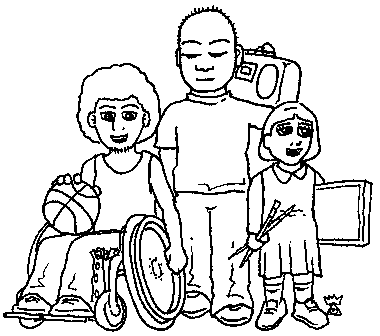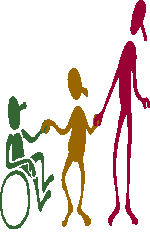
What is a Disability?
Definition
When most people think of the word "disability" they immediately picture someone in a wheelchair. But there are many different types of disability.
People with a disability may include:
- people who are blind or partially sighted
- people with learning or intellectual disabilities
- people who are deaf or hearing impaired
- people with a physical disability
- people with long term illnesses
- people with mental health or psychological difficulties
- people with an acquired brain injury
According to the World Health Organisation, a disability is…
"any restriction or lack (resulting from any impairment) of ability to perform an activity in the manner or within the range considered normal for a human being"
A disability includes those that:
- are present, or
- once existed but don't any more, for example, a person who has had a back injury, a heart attack or an episode of mental illness, or
- may exist in the future, for example, a person with a genetic predisposition to a disease, such as Huntington's disease or heart disease or a person who is HIV positive, or
- someone thinks or assumes a person has.
It is likely that some of the young people who already use your service are young people with disabilities.
Terminology
"Language is critical in shaping and reflecting our thoughts, beliefs, feelings and concepts. Some words by their very nature degrade and diminish people with a disability"
The term "disabled young person" tends to convey a message that the only thing worth mentioning about a person is their disability. It is better to say "young person with a disability" as this emphasises the person first without denying the reality of the disability.
Terms such as cripple, spastic, handicapped, invalid are derogatory, offensive and you should avoid them.
Sometimes people with a disability are compared to normal people. This implies that the person with a disability is abnormal and ignores the fact that everyone has their own unique identity and abilities. For comparisons you could say other people instead.
The Definition Of Disability
|
|
The most commonly cited definition is that of the World Health Organisation in 1976(1), which draws a three-fold distinction between impairment, disability and handicap, defined as follows. 'An impairment is any loss or abnormality of psychological, physiological or anatomical structure or function; a disability is any restriction or lack (resulting from an impairment) of ability to perform an activity in the manner or within the range considered normal for a human being; a handicap is a disadvantage for a given individual, resulting from an impairment or a disability, that prevents the fulfilment of a role that is considered normal (depending on age, sex and social and cultural factors) for that individual'.
According to activists in the disability movement, the World Health Organisation has confused between the terms 'disability' and 'impairment'. They maintain that impairment refers to physical or cognitive limitations that an individual may have, such as the inability to walk or speak. In contrast, disability refers to socially imposed restrictions, that is, the system of social constraints that are imposed on those with impairments by the discriminatory practices of society. Thus, the Union of the Physically Impaired Against Segregation defined impairment and disability in the following manner. An 'impairment [is] lacking part of or all of a limb, or having a defective limb, organism or mechanism of the body'. 'disability [is] the disadvantage or restriction of activity caused by contemporary organisation which takes no or little account of people who have physical impairments and thus excludes them from the mainstream of social activities'(2).
According to the United Nations Standard Rules on the equalization of Opportunities for Persons with disabilities:
- The term "disability" summarizes a great number of different functional limitations occurring in any population in any country, of the world. People may be disabled by physical, intellectual or sensory impairment, medical conditions or mental illness. Such impairments, conditions or illnesses may be permanent or transitory in nature.
- The term "handicap" means the loss or limitation of opportunities to take part in the life of the community on an equal level with others. It describes the encounter between the person with a disability and the environment. The purpose of this term is to emphasize the focus on the shortcomings in the environment and in many organized activities in society, for example, information, communication and education, which prevent persons with disabilities from participating on equal terms.
- The use of the two terms "disability" and "handicap", as defined in the two paragraphs above, should be seen in the light of modern disability history. During the 1970s there was a strong reaction among representatives of organizations of persons with disabilities and professionals in the field of disability against the terminology of the time. The terms "disability" and "handicap" were often used in an unclear and confusing way, which gave poor guidance for policy-making and for political action. The terminology reflected a medical and diagnostic approach, which ignored the imperfections and deficiencies of the surrounding society.
- In 1980, the World Health Organization adopted an international classification of impairments, disabilities and handicaps, which suggested a more precise and at the same time relativistic approach. The International Classification of Impairments, Disabilities, and Handicaps(3) makes a clear distinction between "impairment", "disability" and "handicap". It has been extensively used in areas such as rehabilitation, education, statistics, policy, legislation, demography, sociology, economics and anthropology. Some users have expressed concern that the Classification, in its definition of the term "handicap", may still be considered too medical and too centred on the individual, and may not adequately clarify the interaction between societal conditions or expectations and the abilities of the individual. Those concerns, and others expressed by users during the 12 years since its publication, will be addressed in forthcoming revisions of the Classification.
- As a result of experience gained in the implementation of the World Programme of Action and of the general discussion that took place during the United Nations Decade of Disabled Persons, there was a deepening of knowledge and extension of understanding concerning disability issues and the terminology used. Current terminology recognizes the necessity of addressing both the individual needs (such as rehabilitation and technical aids) and the shortcomings of the society (various obstacles for participation).
NOTES
- World Health Organisation. Document A29/INFDOCI/1, Geneva, Switzerland, 1976.
- Union of the Physically Impaired Against Segregation. Fundamental Principles of Disability, London, 1976.
- World Health Organization, International Classification of Impairments, Disabilities, and Handicaps: A manual of classification relating to the consequences of disease (Geneva, 1980).
|
|


